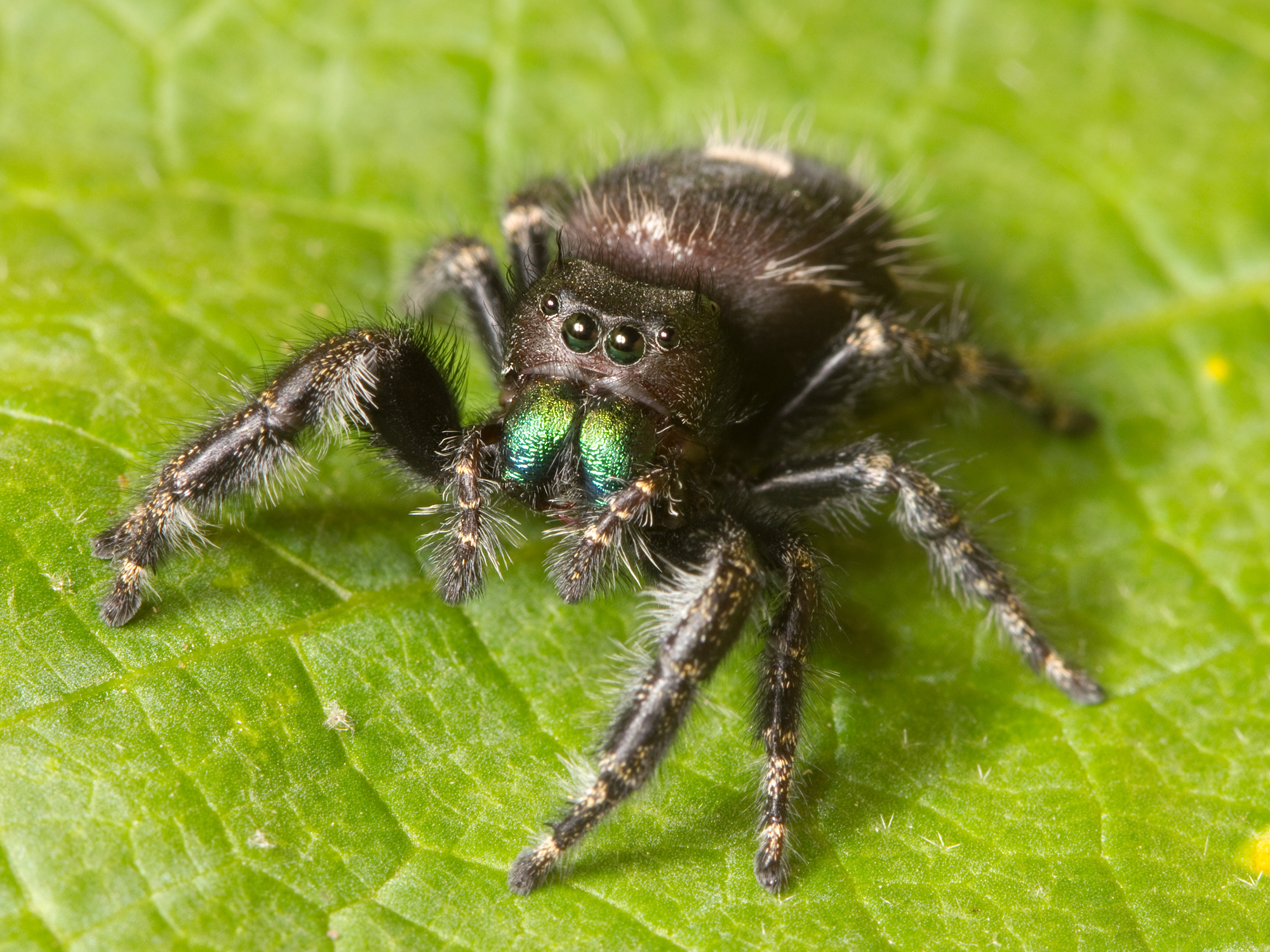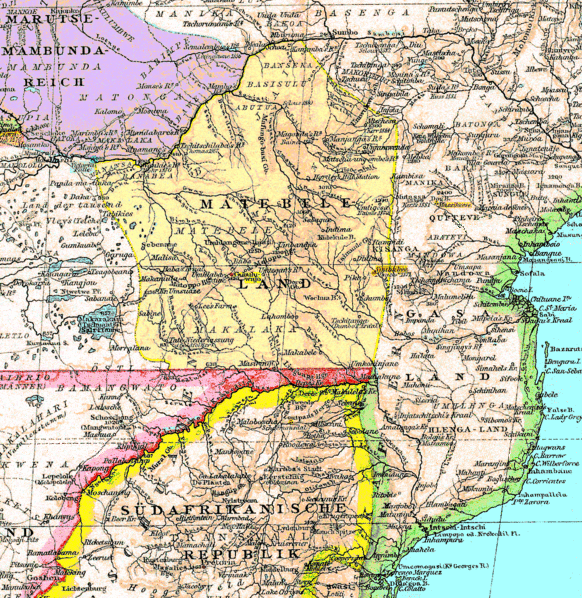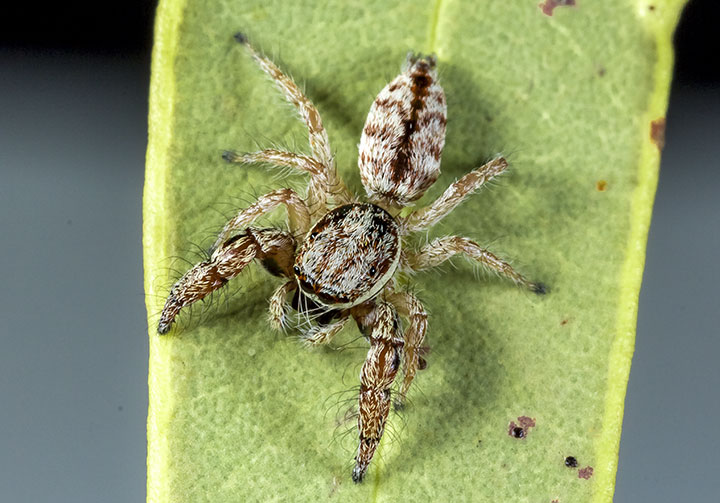|
Pseudicius Matabelensis
''Pseudicius matabelensis'' is a species of jumping spider in the genus ''Pseudicius'' that ilves in Namibia, South Africa and Zimbabwe. The spider was first defined in 2011 by Wanda Wesołowska. The spider is small, with a cephalothorax between long and an abdomen between long. It has a dark brown carapace and olive-brownish abdomen, the latter with an indistinct pattern of two stripes. The male has stout dark brown front legs. The species is similar to the related '' Pseudicius procerus'' but differs in its copulatory organs. The female has two pockets at the front of the epigyne and short seminal ducts leading to large receptacles. The male has a very long tibial apophysis and short embolus. Taxonomy ''Pseudicius matabelensis'' is a jumping spider that was first described by the Polish arachnologist Wanda Wesołowska in 2011. It was one of more than 500 species that she identified in her career, making her one of the most prolific in the discipline. She allocated the specie ... [...More Info...] [...Related Items...] OR: [Wikipedia] [Google] [Baidu] |
Species
In biology, a species is the basic unit of Taxonomy (biology), classification and a taxonomic rank of an organism, as well as a unit of biodiversity. A species is often defined as the largest group of organisms in which any two individuals of the appropriate sexes or mating types can reproduction, produce Fertility, fertile offspring, typically by sexual reproduction. Other ways of defining species include their karyotype, DNA sequence, morphology (biology), morphology, behaviour or ecological niche. In addition, paleontologists use the concept of the chronospecies since fossil reproduction cannot be examined. The most recent rigorous estimate for the total number of species of eukaryotes is between 8 and 8.7 million. However, only about 14% of these had been described by 2011. All species (except viruses) are given a binomial nomenclature, two-part name, a "binomial". The first part of a binomial is the genus to which the species belongs. The second part is called the specifi ... [...More Info...] [...Related Items...] OR: [Wikipedia] [Google] [Baidu] |
Jerzy Prószyński
Jerzy Prószyński (born 1935 in Warsaw) is a Polish arachnologist specializing in systematics of jumping spiders (family Salticidae). He is a graduate of the University of Warsaw, a long-term employee of the Siedlce University of Natural Sciences and Humanities and the Institute of Zoology of the Polish Academy of Sciences in Warsaw. Biography In 1957 he completed his biological studies at the University of Warsaw. During his studies he was employed at the Institute of Zoology of the Polish Academy of Sciences in Warsaw, where he conducted research on spiders in the Kampinos Forest. Between 1963 and 1967 he lectured on zoology at the University of Ghana. In 1966 he obtained his Ph.D. at the Adam Mickiewicz University in Poznań. A year later he was given the opportunity to pursue a postdoctoral fellowship at Harvard University, but he was refused a passport. In 1972 he was employed at the Higher School of Education in Siedlce (later the Siedlce University of Natural Scie ... [...More Info...] [...Related Items...] OR: [Wikipedia] [Google] [Baidu] |
Unidentate
In coordination chemistry, denticity () refers to the number of donor groups in a given ligand that bind to the central metal atom in a coordination complex. In many cases, only one atom in the ligand binds to the metal, so the denticity equals one, and the ligand is said to be monodentate (sometimes called unidentate). Ligands with more than one bonded atom are called polydentate or multidentate. The denticity of a ligand is described with the Greek letter κ ('kappa'). For example, κ6- EDTA describes an EDTA ligand that coordinates through 6 non-contiguous atoms. Denticity is different from hapticity because hapticity refers exclusively to ligands where the coordinating atoms are contiguous. In these cases the η ('eta') notation is used. Bridging ligands use the μ ('mu') notation. Classes Polydentate ligands are chelating agents and classified by their denticity. Some atoms cannot form the maximum possible number of bonds a ligand could make. In that case one or m ... [...More Info...] [...Related Items...] OR: [Wikipedia] [Google] [Baidu] |
Chelicerae
The chelicerae () are the mouthparts of the subphylum Chelicerata, an arthropod group that includes arachnids, horseshoe crabs, and sea spiders. Commonly referred to as " jaws", chelicerae may be shaped as either articulated fangs, or similarly to pincers. Some chelicerae, such as those found on nearly all spiders, are hollow and contain (or are connected to) venom glands, and are used to inject venom into prey or a perceived threat. In '' Pisaurina mira'', also known as the nursery web spider, the chelicerae are utilized to snatch the prey once it becomes within reach, facilitating the "sit-and-wait ambush predator" behavior. Both pseudoscorpions and harvestmen have structures on their chelicerae that are used for grooming (papillae in pseudoscorpions, cheliceral teeth in Opiliones). Types Chelicerae can be divided into three kinds: jackknife chelicerae, scissor chelicerae, and 3-segmented chelate chelicerae. Jackknife chelicerae The jackknife chelicera is subchelate ... [...More Info...] [...Related Items...] OR: [Wikipedia] [Google] [Baidu] |
Spider Vision
The eyes of spiders vary significantly in their structure, arrangement, and function. They usually have eight, each being a simple eye with a single lens (optics), lens rather than multiple units as in the compound eyes of insects. The specific arrangement and structure of the eyes is one of the features used in the identification and classification of different species, genera, and families. Most Haplogynae, haplogynes have six eyes, although some have eight (Plectreuridae), four (e.g., ''Tetrablemma'') or even two (most Caponiidae). In some cave species, there are no eyes at all (e.g. Stalita taenaria). Sometimes one pair of eyes is better developed than the rest. Several families of hunting spiders, such as jumping spiders and wolf spiders, have fair to excellent vision. The main pair of eyes in jumping spiders even sees in colour. Structure and anatomy Spiders' eyes are Simple eye in invertebrates, simple eyes, or ''ocelli'' (singular ''ocellus''), meaning their eyes have a si ... [...More Info...] [...Related Items...] OR: [Wikipedia] [Google] [Baidu] |
Matabeleland
Matabeleland is a region located in southwestern Zimbabwe that is divided into three provinces: Matabeleland North, Bulawayo, and Matabeleland South. These provinces are in the west and south-west of Zimbabwe, between the Limpopo and Zambezi rivers and are further separated from Midlands by the Shangani River in central Zimbabwe. The region is named after its inhabitants, the Ndebele people who were called "Amatabele"(people with long spears - Mzilikazi 's group of people who were escaping the Mfecani wars). Other ethnic groups who inhabit parts of Matabeleland include the Tonga, Bakalanga, Venda, Nambya, Khoisan, Xhosa, Sotho, Tswana, and Tsonga. The population of Matabeleland is just over 20% of the Zimbabwe's total. The capital and largest city is Bulawayo, other notable towns are Plumtree, Victoria Falls, Beitbridge, Lupane, Esigodini, Hwange and Gwanda. The land is fertile but semi arid. This area has coal and gold deposits. Industries include gold ... [...More Info...] [...Related Items...] OR: [Wikipedia] [Google] [Baidu] |
Salticoida
Salticoida is an unranked clade of the jumping spider family Salticidae. It is the larger and more widespread of the two subdivisions of the "typical" jumping spiders (subfamily Salticinae), occurring effectively world-wide. Its sister clade is Amycoida, which is also very diverse ecologically but has a mostly South American distribution. Systematics and evolution Salticoida includes the bulk of extant jumping spider diversity, with over 400 genera organized phylogenetically into 18 tribes according to Wayne Maddison's 2015 proposal. The age and origin of the Salticoida are not well determined. Certainly, by the late Paleogene the major lineages were recognizably distinct as indicated by the fossil evidence and molecular phylogeny. Thus, the salticoids presumably originated during or around the PETM or a bit earlier, but no corresponding fossils have been found yet. Their sister lineage, the Amycoida, probably originated by dispersal across the ocean to South America, which ... [...More Info...] [...Related Items...] OR: [Wikipedia] [Google] [Baidu] |
Subfamily
In biological classification, a subfamily ( Latin: ', plural ') is an auxiliary (intermediate) taxonomic rank, next below family but more inclusive than genus. Standard nomenclature rules end subfamily botanical names with "-oideae", and zoological names with "-inae". See also * International Code of Nomenclature for algae, fungi, and plants The ''International Code of Nomenclature for algae, fungi, and plants'' (ICN) is the set of rules and recommendations dealing with the formal botanical names that are given to plants, fungi and a few other groups of organisms, all those "trad ... * International Code of Zoological Nomenclature * Rank (botany) * Rank (zoology) Sources {{biology-stub ... [...More Info...] [...Related Items...] OR: [Wikipedia] [Google] [Baidu] |
Clade
A clade (), also known as a monophyletic group or natural group, is a group of organisms that are monophyletic – that is, composed of a common ancestor and all its lineal descendants – on a phylogenetic tree. Rather than the English term, the equivalent Latin term ''cladus'' (plural ''cladi'') is often used in taxonomical literature. The common ancestor may be an individual, a population, or a species (extinct or extant). Clades are nested, one in another, as each branch in turn splits into smaller branches. These splits reflect evolutionary history as populations diverged and evolved independently. Clades are termed monophyletic (Greek: "one clan") groups. Over the last few decades, the cladistic approach has revolutionized biological classification and revealed surprising evolutionary relationships among organisms. Increasingly, taxonomists try to avoid naming taxa that are not clades; that is, taxa that are not monophyletic. Some of the relationships between org ... [...More Info...] [...Related Items...] OR: [Wikipedia] [Google] [Baidu] |
Chrysillini
Chrysillini is a tribe of jumping spider in the family Salticidae. In Maddison's 2015 revision of the family, the subfamily Heliophaninae was reclassified as a junior synonym of Chrysillini. Genera * '' Afraflacilla'' * '' Augustaea'' * '' Chrysilla'' * '' Cosmophasis'' * '' Echinussa'' * '' Epocilla'' * ''Festucula'' * ''Hakka'' * ''Helicius'' * '' Heliophanillus'' * ''Heliophanus'' * '' Helvetia'' * '' Icius'' * '' Kupiuka'' * ''Marchena'' * '' Matagaia'' * ''Menemerus'' * ''Mexcala'' * ''Natta'' * '' Ogdenia'' * '' Orsima'' * '' Paraheliophanus'' * '' Phintella'' * '' Plesiopiuka'' * '' Siler'' * '' Tasa'' * '' Theriella'' * ''Wesolowskana'' * ''Yepoella ''Yepoella'' is a monotypic taxon, monotypic genus of Argentinian Salticidae, jumping spiders containing the single species, ''Yepoella crassistyli''. It was first described by María Elena Galiano in 1970, and is found in Argentina. A second spec ...'' References Salticidae Spider tribes ... [...More Info...] [...Related Items...] OR: [Wikipedia] [Google] [Baidu] |
Marchena
''Marchena'' is a genus of jumping spiders only found in the United States. Its only described species, ''M. minuta'', dwells on the barks of conifers along the west coast, especially California, Washington and Nevada.Maddison, Wayne. 1995. Marchena. Marchena minuta. Version 1 January 1995 (under construction). http://tolweb.org/Marchena_minuta/2986/1995.01.01 in The Tree of Life Web Project, http://tolweb.org/ It forms a monophyletic group with the genera '' Afraflacilla'', '' Pseudicius'' and ''Festucula''.Zabka & Grey 2002 Description This species can easily be distinguished from others in its range by the tubercles on the first femur of its first legs. ''M. minuta'' has a body length of about 4 mm. Name The genus name is probably derived from the Spanish city of Marchena, Seville. As witnessed by other generic names, the describers had a habit of naming taxa after places unrelated to the species' distribution. The species name is Latin for "small, minute". No ... [...More Info...] [...Related Items...] OR: [Wikipedia] [Google] [Baidu] |
Afraflacilla
''Afraflacilla'' is a genus of the spider family Salticidae (jumping spiders). Most species are distributed in Eastern to Northern Africa (including the Middle East) and Australia, with two species (''A. epiblemoides and A. tarajalis'') found in Europe. This genus was for a time included in the genus '' Pseudicius'', and the boundaries between both genera are disputed. In 2016 Jerzy Prószyński erected the genus ''Psenuc'' for some borderline species. The name ''Afraflacilla'' is combined from Africa, where most earlier described species were found, and ''Flacilla'' Simon, 1901, an obsolete salticid genus now called ''Flacillula'' Strand, 1932. This genus name is in turn derived from Aelia Flaccilla, wife of Roman Emperor Theodosius I. ''Afraflacilla'', '' Pseudicius'', ''Festucula'' and ''Marchena'' are close relatives and form a monophyletic group. Afraflacilla species have tubercles and bristles (on the sides of the carapace near the eyes and on their legs) which they ... [...More Info...] [...Related Items...] OR: [Wikipedia] [Google] [Baidu] |





